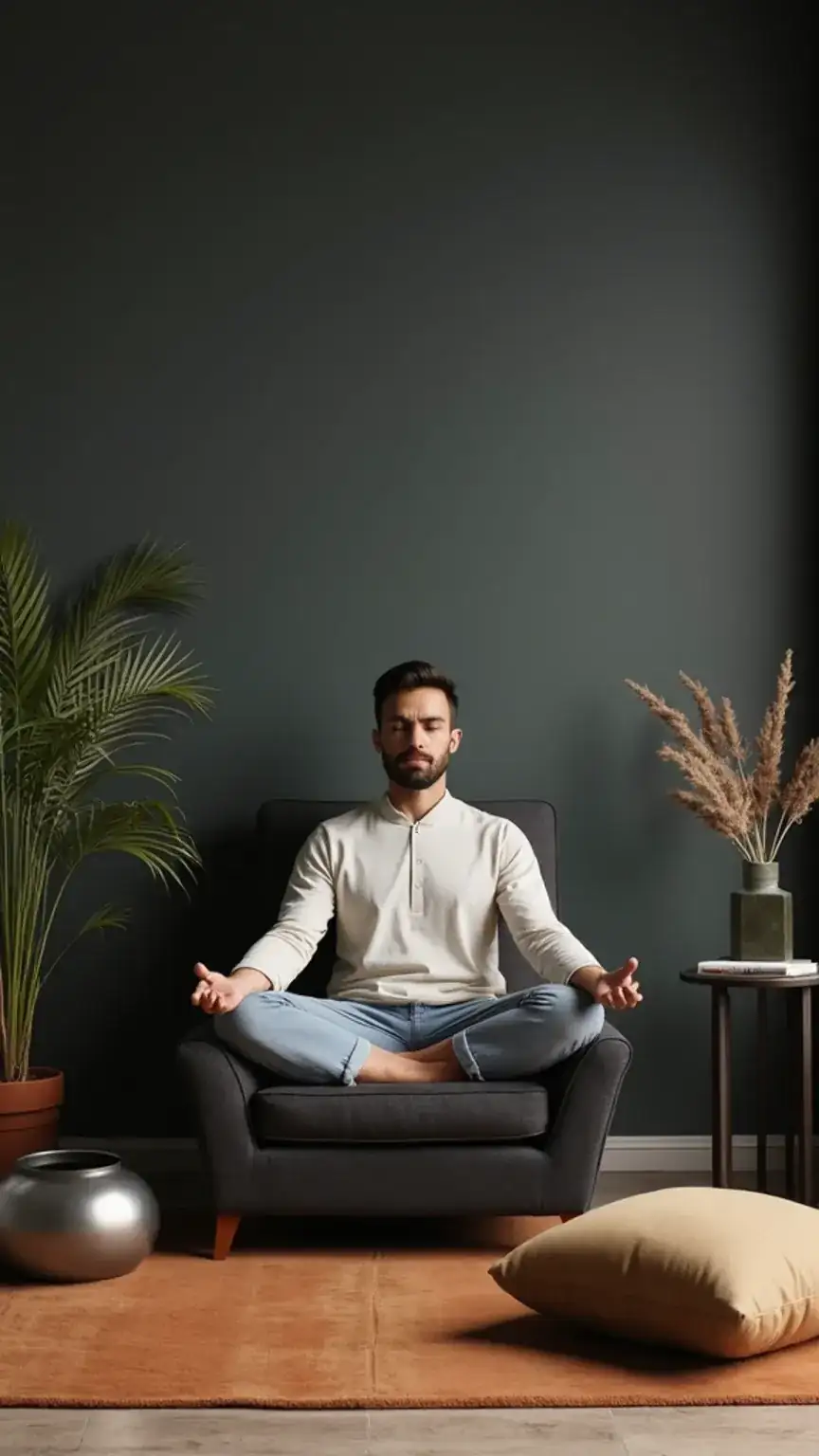As a guy who’s navigated the choppy waters of modern life, I know firsthand how overwhelming stress and anxiety can feel. We’re often told to “man up” or “tough it out,” but let’s be honest, that approach rarely works long-term. The good news? There are practical, actionable strategies to help you regain control and cultivate a calmer, more centered existence. Think of this as your personal toolkit for mastering stress and anxiety, designed for the modern man who’s ready to live life with more substance.

Understanding the Landscape of Stress
Before we dive into solutions, it’s vital to understand what we’re up against. Stress and anxiety aren’t weaknesses; they’re natural responses to life’s demands. However, when these responses become chronic, they can significantly impact your well-being, relationships, and even your professional performance. Ladies, if you’re looking to understand the men in your life better, or simply seeking ways to support them, this guide offers valuable insights into navigating these common challenges.
Step 1: Identify Your Stressors – The Root Cause Analysis
The first, and perhaps most critical, step in managing stress and anxiety is to pinpoint what’s actually triggering it. This isn’t about dwelling on the negative; it’s about gaining clarity. Take a moment to reflect. Is it the pressure cooker of your career? The complexities of personal relationships? Financial worries? Perhaps it’s the constant barrage of information from our devices? Once you can identify the specific sources, you’re halfway to developing a targeted strategy to address them.

For example, Dave, a 45-year-old accountant I know, realized his anxiety spiked every Sunday evening. After some introspection, he identified that it was the looming workload and the feeling of being unprepared for the week ahead. By simply reorganizing his Sunday afternoon to plan his week and tackle a few small tasks, he found his Sunday night dread significantly diminished. This proactive approach is surprisingly effective.
Step 2: Embrace Mindfulness – The Power of Presence
Mindfulness is essentially about being fully present in the moment, without judgment. It’s a practice that helps to quiet the mental chatter that often fuels anxiety. You can cultivate mindfulness through various methods. Meditation is a popular choice, but even simple deep breathing exercises can make a profound difference. Try focusing on the sensation of the air entering and leaving your lungs.

Furthermore, you can practice mindfulness by simply paying attention to your senses throughout the day. What do you see, hear, smell, taste, and feel right now? This anchors you in the present. Apps like Headspace or Calm offer guided sessions that make it easy to get started, even if you only have a few minutes. Remember, consistency is key, not perfection.
Step 3: Fuel Your Fire with Physical Activity – The Natural Antidote
Exercise is a powerful, natural stress-reliever. It releases endorphins, those feel-good chemicals that act as natural mood boosters and pain relievers. You don’t need to run a marathon or spend hours in the gym. Even a brisk 10-minute walk can make a significant difference. Try incorporating a few push-ups or squats into your routine.

The key is to find an activity you genuinely enjoy. Whether it’s hiking through nature, playing a pickup game of basketball with friends, or finding your flow with yoga, engaging in physical activity that sparks joy will make it a sustainable habit. Imagine the sense of accomplishment after a good workout – that feeling can carry over into your mental state. Plus, it’s a fantastic way to clear your head.
Step 4: Cultivate Connection – The Strength in Support
Human connection is a cornerstone of mental well-being. Social support acts as a buffer against stress and anxiety. Make a conscious effort to schedule time for friends and family. These relationships provide a sense of belonging and an outlet for sharing your experiences. Don’t underestimate the power of a good conversation with a trusted friend.

However, sometimes, the challenges we face require more than casual conversation. If you find yourself consistently struggling, don’t hesitate to reach out to a therapist or counselor. They can provide specialized tools and strategies tailored to your needs. Similarly, joining a support group can connect you with others who understand your experiences, fostering a sense of community and shared resilience.
Step 5: Prioritize Self-Care – Investing in Your Well-being
Self-care isn’t selfish; it’s essential maintenance for your mind and body. This means actively tending to your physical and emotional needs. Ensure you’re getting adequate sleep, as sleep deprivation significantly exacerbates stress and anxiety. Aim for 7-9 hours of quality sleep per night.

Furthermore, nourish your body with a balanced diet. What you eat directly impacts your mood and energy levels. Incorporate plenty of fruits, vegetables, and whole grains. Beyond these fundamentals, explore activities that help you relax and recharge. This could be reading a good book, listening to your favorite music, taking a long, relaxing bath, or pursuing a hobby you love.
Step 6: Master Your Digital Domain – Technology as a Tool, Not a Tyrant
In today’s hyper-connected world, it’s easy to get swept up in the constant stream of notifications and social media updates. This digital deluge can be a significant source of stress and anxiety. Therefore, it’s crucial to set healthy boundaries for your technology use. Be intentional about when and how you engage with your devices.

Consider using apps designed to help you stay focused and reduce distractions. Tools like Freedom or SelfControl can temporarily block access to time-wasting websites and apps, allowing you to dedicate more focused time to work or relaxation. This intentionality with technology can significantly boost your mental clarity.
Step 7: Develop Resilience Through Routine – Building a Stable Foundation
Establishing consistent routines can provide a sense of stability and control, which are invaluable when dealing with stress and anxiety. This doesn’t mean rigid, inflexible schedules, but rather predictable patterns that support your well-being. A consistent wake-up and bedtime, regular meal times, and dedicated slots for exercise and relaxation can create a reliable framework for your day.

Think of your routine as the scaffolding that supports your efforts to manage stress. When unexpected challenges arise, having a solid routine in place provides a stable base from which to operate. This predictability can significantly reduce the feeling of being overwhelmed, allowing you to approach each day with more confidence. Furthermore, consistent healthy habits build long-term resilience.
Step 8: Practice Gratitude – Shifting Your Perspective
Gratitude is a powerful antidote to anxiety and stress. It shifts your focus from what’s lacking or problematic to what’s abundant and positive in your life. Regularly taking time to acknowledge and appreciate the good things, no matter how small, can profoundly impact your mental state. This is about actively looking for the silver linings.
You can incorporate gratitude into your daily life in several ways. Consider keeping a gratitude journal, where you jot down three to five things you’re thankful for each day. Alternatively, you can simply take a moment before bed to mentally review your blessings. This simple practice can rewire your brain to notice the positive, fostering a more optimistic outlook. Ladies, encouraging your partner to try this can be a subtle yet impactful way to support their mental well-being.
Step 9: Learn to Say “No” – Protecting Your Energy
One of the most underrated stress management techniques is the ability to politely decline requests that overextend you. It’s easy to fall into the trap of trying to please everyone, but this often leads to burnout and increased anxiety. Setting boundaries is a form of self-respect and essential for maintaining your mental equilibrium.
When faced with a request, take a moment before committing. If it doesn’t align with your priorities or you genuinely don’t have the capacity, it’s perfectly acceptable to say no. You can do this kindly and respectfully. For instance, instead of a blunt “no,” you could say, “I appreciate you asking, but I’m unable to take on any additional commitments right now.” This protects your energy and ensures you can focus on what truly matters.
Step 10: Seek Professional Guidance When Needed – It’s a Sign of Strength
While these strategies are effective, there are times when professional help is not just beneficial, but necessary. If stress and anxiety are persistently impacting your life, making it difficult to function, seeking guidance from a mental health professional is a sign of strength, not weakness. Therapists and counselors are trained to provide evidence-based techniques and support.
For example, the 90% of recruiters who judge your credibility by your profile pic—a statistic that can induce stress—is a small example of how external pressures can mount. A professional can help you develop coping mechanisms for such specific anxieties. They can offer personalized strategies, such as Cognitive Behavioral Therapy (CBT), which is highly effective in managing anxiety disorders. Remember, investing in your mental health is one of the most important investments you can make.
Conclusion: Empowering Your Journey to Calm
Mastering stress and anxiety is an ongoing journey, not a destination. By integrating these practical strategies into your daily life, you can build a more resilient mind and a calmer existence. Remember to be patient and kind to yourself throughout this process. Progress often comes in small, consistent steps.
Your future self will undoubtedly thank you for taking the time to prioritize your mental well-being today. By adopting these habits, you’re not just managing stress; you’re cultivating a life of greater presence, purpose, and peace.
Ready to take control? Start by pinpointing your biggest stress trigger — then commit to testing one new mindfulness tactic this week. Small shifts lead to big results.
And if part of that stress comes from juggling fatherhood and career, don’t miss this guide to mastering work-life balance as a dad. It’s built for real life — not theory — and might just be your next best move.






